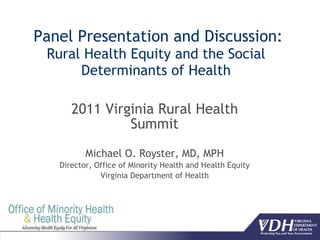
Health Equity
- 1. Panel Presentation and Discussion: Rural Health Equity and the Social Determinants of Health 2011 Virginia Rural Health Summit Michael O. Royster, MD, MPH Director, Office of Minority Health and Health Equity Virginia Department of Health
- 5. Health Equity and SDOH Framework
- 7. All rural Virginians should have the opportunity to make choices that allow them to live long, healthy lives, regardless of their education, income, race, ethnicity, place of residence, gender…
Editor's Notes
- Good morning, I’m Mike Royster, the director of OMHHE within the VDH and I will be the moderator for this session.
- Disparities are differences Inequities are differences that are: Systemic patterned and predictable Avoidable not inevitable, but socially produced
- Definition of health equity, which is the goal in eliminating health inequities. Societal efforts beyond individual knowledge and behavior change The conditions for health include what we refer to as the SDOH. As defined by the CDC, Social determinants of health (SDOH) are the complex, integrated, and overlapping social structures and economic systems that include the social environment, physical environment, and health services and structural and societal factors that are responsible for most health inequities. SDOH are shaped by the distribution of money, power and resources which are themselves influenced by policy choices. With a specific focus on populations that have experienced socioeconomic disadvantage and historical injustice, which has resulted in systematic differences in access to the SDOH among racial/ethnic minority and low income populations. Such disadvantage creates unequal opportunities to be healthy.
- This diagram visually depicts the concept of health equity and the SDOH. Inner circle Individual determinants Next circle Behaviors; usually the focus of our efforts Outer circle SDOH that influence behaviors including…access to health care Outer most circle SDoHE, are those policy decisions, economic conditions, and social structures that shape the distribution of SDOH among SES groups; R/E groups; gender; residence (urban-rural); etc. Efforts to reduce health inequities usually focus on the individual behavior ring of the diagram. However, the outer 2 rings must be focused on as well to effectively promote rural health equity.
- In Rural Virginia, there are multiple dimensions of health inequities: The most obvious being rural vs. urban But within rural areas, there are also inequities among subpopulations; most prominently along SES, R/E, and gender; but also sexual orientation, ability, etc.
- So this panel presentation and discussion are about promoting rural health equity, which is really about assuring that all Virginians…whether those choices are to purchase healthy foods in your neighborhood, or to live in a healthy neighborhood with many opportunities to be healthy, including high performing schools, job opportunities, freedom from environmental toxins or violence. Introduce the panel
